Aviation and spacecraft engineering. Рубрика в журнале - Siberian Aerospace Journal
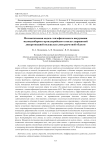
Статья научная
In the conditions of continuous financing of the programs of the Ministry of defense of the Russian Federation, the question of finding the most effective ways to modernize weapons and military (special) equipment, the developments in which are maximum and the processes of their improvement can take no more than a few years, is particularly acute. Such products, in particular, include aviation artillery weapons (AAO), the prospects for the use of which remain for the entire period of the army's existence with conventional weapons. The main factor influencing the quality of the AAO functioning is considered to be the thermophysical loading of a small-caliber artillery barrel (hereinafter referred to as the barrel) during firing. The problem of increasing the accuracy of determining the temperature field of the barrel is again updated by tightening the conditions for striking targets. Issues closely related to the intensification of AAO application regimes have come to the fore. These are issues of heating, cooling, thermal strength, wear, barrel survivability, issues of safety and firing efficiency. Despite the methodological evidence of analytical and numerical approaches to formalizing heat transfer in the wellbore, their practical implementation is rather complicated. The physical and mathematical meaning of this reason is as follows: possible instability of solutions; manifestation of oscillations in areas of large gradients; simultaneous presence in the solution regions of supersonic, sonic and subsonic zones; the existence of laminar, turbulent flows and other non-linear formations; non-triviality of setting boundary conditions; the presence of thermal resistance of surfaces, etc. However, the practical needs of ensuring safety and increasing the efficiency of fire operation of AAO dictate the need to obtain a close approximation of the problem under consideration to its possibly existing exact analytical solution. The aim of the work is to improve the mathematical apparatus that simulates the temperature field of the shaft based on a combination of heat transfer methods and mathematical physics. By verifying the reliability of the developed mathematical model (hereinafter referred to as the model, if from the context of the presentation of the material it is clear that we are talking about the proposed tools), the facts of the absence of methodological errors in the formation of the constituent blocks of the model and the increase in the accuracy of determining the thermal loading of the wellbore by 9.4 % were established. Based on the accents of the stated problem, the directions for improving the model are argued.
Бесплатно

Measurement of temperature distribution using a three-wire system of sensors based on thermistors
Статья научная
Improving the reliability and increasing the avionics resource is associated with possibility of continuous control of temperature fields of printed circuit boards. This problem can be solved only with the use of a large number of temperature sensors. It raises the problem of connecting the measuring elements and recording equipment. Several methods with their own advantages and disadvantages are proposed. One of the implemented and patented methods is using a set of resistive diode sensors installed in series on a threewire line. The temperature sensors are pairs of counter - connected diodes with a sequential survey when applying sawtooth voltage. The system is simple and easy to implement, but its main drawback is the method of determining the temperature by measuring the amplitude of the total reverse currents of diode pairs. It determines the large measurement errors, especially in the temperature range less than 20°C. The article deals with a similar design of a three-wire circuit, but with a fundamentally different approach to temperature measurement. The temperature sensor here is not diode pairs, but thermistors with a well-known dependence of resistance on temperature and high accuracy, and diode pairs record only the moment of coincidence of the sawtooth voltage with the voltage on the thermistors. This approach allows using mathematical methods of signal processing to accurately determine the voltage drop on the thermistor, and this ensures the accuracy of the resistance/temperature and the expansion of the temperature range. Given the fact that thermistors are increasingly used to measure temperature, simplifying their inclusion in a large number will allow to register the temperature field of electronic units, which is extremely important for spacecraft. The proposed version of a three-wire circuit for connecting temperature sensors at several points was tested experimentally, including at negative temperatures.
Бесплатно

Статья научная
Based on the previously compiled physical and mathematical model of the vortex ejector workflow, its solution was made. The solution of this model made it possible to compile two calculation methods: a method for calculating the optimal geometry of a vortex ejector for given thermodynamic characteristics and a method for calculating the thermodynamic characteristics of a vortex ejector with known geometric dimensions [1; 2]. Vortex ejectors are used in many areas of aerospace engineering. The compiled development of a method for calculating the thermodynamic characteristics of a vortex ejector with known geometric dimensions will make it possible to use vortex ejectors more widely in the aerospace industry. The calculation method is based on the concepts of tangential stresses arising in a viscous medium when two flows moving at different speeds interact. The mechanism of kinetic energy transfer from a high-energy gas to a low-energy one is shown.
Бесплатно
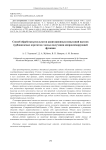
Статья научная
When designing rocket engines, the problem of providing the specified basic design parameters is solved. In connection with the increase in requirements for products of rocket and space technology, the requirements for ensuring the energy efficiency of all its constituent elements are also increasing. As a rule, the task of increasing the energy characteristics of a rocket engine is carried out by increasing the pressure in the combustion chamber and the rotational speed of the turbopump shaft. An increase in the rotational speed of the shaft of a turbopump unit requires the provision of a cavitation-free operation of the pump with the absence of cavitation breakdown. This problem can be solved in various ways: by constructive improvement of the pump or by increasing the pressure parameter at the pump inlet. However, too much increase in inlet pressure is not possible, as this will increase the thickness of the walls of the rocket's fuel tanks and a corresponding increase in the mass of the entire rocket. Turning on the screw, although it does not guarantee cavitation-free operation at any inlet pressure, is the most preferred method. The geometry of the bore part of both the screw prepump and the pump blades is designed to ensure non-cavitational operation. When designing, at the stage of experimental testing of pump modes, it is pos-sible to use the methods of computational fluid dynamics (Computational Fluid Dynamics, CFD). These methods are used in various areas of general engineering and have proven themselves well. However, the rocket motor pump has a high pressure drop with relatively small dimensions. The question arises of adapt-ing CFD methods to modeling cavitation tests. This work is aimed at deriving a function approximating the TPU test data set with a view to its further adaptation for CFD methods.
Бесплатно
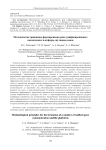
Статья научная
This article formulates the topical problem of formalizing the methodological principles of the search for a compromise between properties repeatability and modification (novelty) for the new models of space technology – communication satellites. The main methodological principles of development continuity are the unification of products and their component parts, means of technological equipment and technological processes, which allows to reduce their diversity and nomenclature. The order of the nomenclature of the articles and their component parts is achieved by developing parametric and type-size series with rationally chosen intervals between the adjacent members of the series according to a complex criterion, a link to the target product performance with the cost of creating the product. The research develops a project model and defines criteria for selecting the size type of a universal space platform. In designing a new spacecraft on the basis of a unified space platform (USP), there is a need to refine it to meet the resource requirements of the new payload (mass and energy consumption). The article sets out the methodological principles for assessing the range of effective applications of the universal space platform for the two most extreme cases of resource requirements (by mass and energy consumption) of the payload: the resources of the platform are excessive or insufficient. Methodological principles have been developed to form a number of unified space platforms. Using the methodological principles for the formation of a series of unified space platforms, the effectiveness ranges of USP were evaluated and the completeness of a number of geostationary communication satellites developed by “ISS” was assessed.
Бесплатно

Methodological principles of space vehicle design for the maximum energy supply of the payload
Статья научная
The design of spacecraft at the initial stages is carried out in the presence of uncertainties in terms of parameters and conditions. The determination of design parameters is performed step by step: determination of the nominal values of design parameters, normalization of resource reserves (mass, volume, energy consumption) according to the design parameters to parry uncertainties, designing spacecraft for marginal resources. The operation of spacecraft with an electrical load switched on includes several stages: launching into the target orbit, putting into regular operation, regular operation for the intended purpose, decommissioning from the intended use in case of emergencies. The power supply system is designed to provide uninterrupted autonomous power supply to the onboard equipment in all modes and at all stages during the period of active existence of spacecraft, taking into account the presence of shadow zones of the orbit from the Earth and the Moon. In this article, the methodological principles for designing spacecraft for the maximum power supply of payload in the presence of uncertainties in parameters and conditions are developed. The mathematical models for calculating the parameters of the energy balance of spacecraft have been developed for various options for realizing the power of the session load, depending on the level of illumination of the orbit and the period of operation of spacecraft. The effectiveness of using the methodological principles of designing spacecraft for the maximum power supply of the payload, depending on the level of illumination of the orbit and the period of operation of spacecraft, has been evaluated. A technique has been developed for rationing reserves by spacecraft energy resources to parry uncertainties in terms of parameters and conditions, as well as the principles of its application when designing spacecraft for maximum payload power supply.
Бесплатно
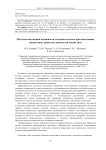
Methodology for assessing reliability of stand-bed systems in testing liquid throat engines
Статья научная
In the process of design processing of low thrust rocket engines great attention is paid to special bench test methodologies, technical use of benches, simulation measurements of the physical conditions of outer space, as well as the use of diagnostic studies and equipment for various physical studies and measurements. The efficiency of ground (bench) testing is ensured by simulating the conditions of full-scale tests and taking into account the influence of all operational factors affecting the reliability of the assessment of reliability indicators during design testing in ground conditions. A special place in the issues of achieving test efficiency is occupied by the requirements to ensure the accuracy and reliability of test results. A significant amount of testing during the development of engines should be carried out under the required vacuum conditions on test benches equipped with pressure chambers with vacuum systems. As a result of failures of some elements of a complex bench system, the quality of functioning deteriorates and the probability of successful performance of the functions that determine the output effect of the system decreases. Therefore, the task of evaluating the reliability of the systems of the stand for firing tests of rocket engines is reduced to elucidating the effect of element failures on the quality of operation and the output effect of each system. When testing, the given conditions must unambiguously determine the technical characteristics of the test stand, including the pressure chamber and vacuum equipment. Tests must be carried out with a sufficient degree of certainty. When assessing the dynamic characteristics in pulsed modes, significant errors are introduced by inertial forces. Methods for ensuring the dynamic similarity of the characteristics of the engine supply systems with fuel components on the stand and as part of the propulsion system of the spacecraft, including the correspondence of the hydraulic, inertial and wave characteristics of the mains, are considered. An analysis of the errors in the test results was carried out. The tasks of the methodology for calculating instrumental errors are formulated. An assessment of the frequency characteristics of bench hydraulic lines was carried out. Recommendations have been developed to improve the accuracy of measuring parameters during bench firing tests of low-thrust rocket engines.
Бесплатно
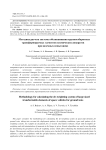
Статья научная
This paper considers the methodology for calculating the de-weighting system of spacecraft elements for ground tests, taking into account the deployment options, de-weighting conditions, types and options of de-weighting systems. An example of calculation for a 3-section solar battery without a beam with incomplete de-weighting and with minimization of moments in the hinges is given. Genetic algorithms are used as an algorithm for determining the parameters of the de-weighting system, which allows obtaining the minimum moments in the hinges. The moments and forces acting in the system were checked by plotting diagrams in the expanded state. In addition, a check for compliance with the specified distance, based on design constraints, between the points of application of the weighting forces was made.
Бесплатно
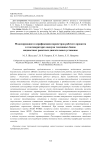
Статья научная
The main requirements for LRE gas generators are high stability of operation, ease of workflow management, as well as high efficiency of the generator gas. A particularly difficult task is to ensure the sustainability of the workflow. In addition to the probability of transverse vibrations in the in-chamber volume, due to the presence of additional volumes of various configurations and lengths attached to the reaction chamber, acoustic vibrations of complex longitudinal modes may occur. Most of the existing methods of testing a gas generator are criterion-empirical in nature and are based on the processing of experimental results, which does not always provide the required accuracy of calculating dynamic and thermal characteristics. The need for experimental and theoretical refinement of the calculation methods of thermodynamic processes of gas generators is an urgent task that will significantly reduce the material and time costs for preliminary design, testing and fine-tuning of modern models of engines and power plants of aircraft. Therefore, the calculation and analysis of the LRE gas generator is an important stage in the design and development of modern engine designs. Using the finite element method of the SOLID WORKS software package, a model of a two-zone gas generator for supercharging fuel tanks of the LRE was built. A study was conducted on modeling the workflow in a gas generator, visualization of thermodynamic processes in the product was built, numerical characteristics were obtained. The method of autonomous bench (firing) tests of fuel tank supercharger gas generators, the method of verification of numerical methods are considered.
Бесплатно
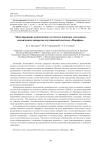
Modeling of composite mesh adapter for Marathon satellite system spacecraft output
Статья научная
Composite shells of rotation of mesh type are often used in the production of rocket and space technology as power elements of structures for various purposes, including spacecraft hulls. High specific values of mechanical characteristics of composites allow to manufacture structures with a high degree of weight perfection. Usually composite mesh structure has the form of a cylindrical or conical shell of circu-lar cross-section and consists of a system of spiral and circular ribs running along the midpoints of the areas between the nodes of intersection of spiral ribs. The discrete structure of the mesh shell is relatively simple and can be manufactured by the method of continuous winding of composite fibers, which is very technologically advanced, wellestablished and therefore currently widespread. A characteristic example of anisogrid cylindrical and conical shells is the spacecraft adapter for GLONASS satellites orbit launching, different variants of which are still produced in the workshops of Reshetnev JSC. The shells differ in dimensional parameters (diameters and lengths) and bearing capacity, but they are structurally identical, which allows to develop a universal and maximally automated modeling and calculation procedure. This is extremely important for composite elements of rocket-space technology, which have numerous variable parameters. The optimal combination of these parameters is determined in the process of performing a complex numerical experiment. The composite mesh adapter considered in this paper, designed for the Marathon satellite orbit, differs from the previously used shell structures by the shape of the cross-section, which in the main part is a regular octagon. The previously developed algorithm for modeling an anisogrid structure with a system of spiral and annular ribs formed by unidirectional carbon fiber-reinforced plastic fibers is used. Numerical in-vestigation of stability, stiffness and stress-strain state of the structure is carried out in the environment of an integrated package of finite element programs while varying the main parameters of its mesh structure formation.
Бесплатно

Статья научная
One of the promising areas for improving the methods of manufacturing structural elements of rocket and space technology is the use of selective laser melting technology which represents a unique opportunity to manufacture metal products by melting powder and producing a one-piece solid phase structure. However, pores and other structural defects can appear in the formed element during laser sintering which causes a decrease in the strength characteristics of the parts produced. An important step in the additive technologies introduction is the development of methodology for the preliminary prediction of the strength characteristics of manufactured structural elements under the influence of mechanical loads with the help of mathematical modeling. The methodology for estimating the material strength reduction of a rocket-space technology element obtained using additive technologies by simulating a porous structure and calculating the characteristics of the stress-strain state is presented. The proposed mathematical model and the methodology for calculating the specimen loading on the basis of the distortion energy theory allow calculating the stress-strain state in the process of numerical simulation for different values of the pore diameter. The reduction in yield strength due to the material porosity of the part is estimated using a coefficient equal to the ratio of equivalent stresses arising when a load is applied to a specimen manufactured using traditional and additive technologies. The value of the introduced coefficient characterizes the structure of the grown product and is considered as a function of the random arrangement of pores in the specimen under study. The appearance of pores is the result of a combination of factors: the composition and dispersion of the original metal powder, feed rate, removal distance and laser power during sintering, part orientation and sintering direction, the height of the level of powder deposited on a special base before sintering, etc. The paper evaluates the reduction in strength for the working part of a series of tensile test specimens grown from metal powder of different dispersity. The non-linear nature of the dependence of the yield strength on the particle diameter of the original metal powder is established. The maximum value of the yield strength corresponds to the specimen with the minimum value of the total surface area of the pores.
Бесплатно

On an alternative method for testing the dynamic strength of a small spacecraft structure
Статья научная
This article presents an analysis of the possibility of applying an alternative approach to testing the mechanical effects of the design of a small spacecraft for remote sensing of the Earth, which has an analog product that has passed a full cycle of ground experimental testing. However, despite the similar power scheme and the maximum borrowing of onboard equipment with minimal modifications, the spacecraft planned for testing has a number of significant differences. The application of the main alternative strategies in foreign and domestic practice in the ground-based experimental development of space technology is considered, their advantages and disadvantages are described. Some criteria for decision-making on the rejection of the use of traditional methods of ground-based experimental testing of space technology for mechanical effects are given. The analysis of the normative and technical documentation adopted in the domestic industry in terms of clarifying the list of development tests of spacecraft, the assumptions of applying the computational and experimental method to the development of dynamic (vibration) strength and the analysis of the design of the spacecraft planned for testing in comparison with an analog product showed that the most preferred method of testing dynamic (vibration) strength is the strategy “protocol qualifications”. In accordance with the chosen strategy, a list of tasks was defined that will clarify the nomenclature of the development tests of the research object.
Бесплатно

On the issue of hydrodynamic braking efficiency dur-ing high-velocity tests on a rocket-rail track
Статья научная
At present, the creation of high-velocity aircraft is a promising direction in the development of aircraft and armament both in Russia and abroad. The increase in velocity characteristics of newly developed sam-ples imposes new requirements on test bench equipment, including rocket-rail tracks. The requirements are growing both for the acceleration and braking means, which ensure the tested materiel safety. The proposed work deals with a hydrodynamic braking method used in high-velocity dynamic tests on a rocket-rail track at the Federal State Enterprise “State Governmental Scientific-Testing Area of Aircraft Systems named after L.K. Safronov". The paper gives the description of the braking devices, presents the dependencies determining the calculated values of the braking force developed by them, and describes the braking intensity control methods, which increase the efficiency and safety of braking as well as expand the permissible speed range of the hydrodynamic braking device application. The method of increasing the efficiency of the braking devices functioning by using a special form of its working part profile is presented. The corresponding examples of the braking modes are given for a comparative assessment of the braking efficiency parameters when using braking devices with special and triangular profiles. The working part profile of the hydrodynamic braking device calculated according to the proposed method provides more efficient and safe braking compared with the previously used triangular profile, by maintaining a constant stopping force in a wide velocity range.
Бесплатно
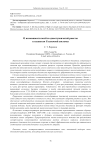
On the possibility of flight of a single-stage rocket to the planets of the Solar system
Статья научная
A new concept for building a small-sized rocket engine containing a special gas ionizer in the combus-tion chamber to increase its conductivity to an optimal value with a corresponding improvement in the fuel combustion process is proposed. A simplified calculation for the relative velocity of gases in a conical noz-zle is given when heating the supersonic flow of gases by plasma in a conical nozzle by means of a power-ful, electromagnetic, high-frequency field, and the influence of some technical parameters on the efficiency of the rocket's flight is also considered. A comparison of the flight altitude of a rocket with plasma heating of the gas flow in a conical nozzle with a scale model corresponding to the well-known single-stage Zenit rocket with the same weight and geometry, taking into account air resistance for the cargo version of the rocket with one small-sized engine, is made. The result is a significant reduction in fuel consumption and an increase in the maximum flight altitude by 2 times with an increase in specific impulse by 2.7 times, other things being equal. It is estab-lished that under certain conceptual parameters, it is possible to rapidly accelerate and fly a single-stage cargo rocket with a launch weight of 17.25-20.00 tons to the planets of the solar system directly from the Earth's surface using a bunch of engines of the same type. The use of many of the same type of small-sized engines allows you to abandon the Laval nozzle in favor of a simple conical nozzle, which reduces the size of the rocket as a whole. This is determined by the need to reduce the diameter of the conical nozzle in order to achieve a greater specific heating power of the plasma compared to the specific power of the fuel burned in the combustion chamber. It is also proposed a complete rejection of the steering engines, the function of which will be performed by part of the engines located closer to the diameter of the rocket. As electric generators, it is proposed to use promising prototypes of electric generators MEG-6NS, MEG-15NS and others, the company "NaukaSoft", with good weight indicators that allow in the future producing such a liquid propellant rocket engine (LPE) of small dimensions. The redistribution of part of the fuel used to produce electricity is compensated by a significant increase in the specific impulse of the LPE to increase the speed and overall efficiency of the flight with an optimal ratio of the amount of fuel to the weight of the rocket before refueling.
Бесплатно
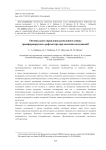
Статья научная
One of the promising types of spacecrafts are large-size transformable reflectors. Such apparatuses are delivered to a target orbit folded, and then deployed to a working condition. The large aperture allows sig-nificantly expanding the capabilities of the antenna. In this case, the tasks arise of a smooth and reliable deployment, adjusting the shape of a radio-reflecting net, and adjusting the orbital position. Due to the fact that the deployment process takes a long time, accounting for disturbing influences is an important prob-lem. The presence of radiation, large temperature differences, solar wind affect the entire system and main-ly on the directional diagram. It is also necessary to smoothly deploy the structural elements, since with an increase in the diameter of the radio-reflecting surface, the moments of inertia of the antenna increase, which leads to prolonged oscillations. In this paper, the process of deployment of the reflector spokes in the presence of disturbances and measurement errors is considered. The solution to the problem is presented using the separation theorem. To estimate the parameters of the system in the presence of measurement noise, the Kalman filter is applied. Its performance is shown at various values of the noise intensity. A ran-dom process such as white noise was selected as external disturbances and measurement noises. The con-trol problem is solved using the optimal control algorithm according to the hierarchy of target criteria. The possibility of minimizing energy costs by means of interval switching on of measuring sensors is shown. The results of numerical simulation are presented.
Бесплатно
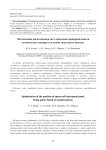
Optimization the position of the spacecraft instrument panel mounting points based on modal analysis
Статья научная
The paper presents optimization of the location of interface points of the spacecraft instrument panel using modal analysis, as well as a quasi-static calculation of the panel under study, confirming effective-ness of proposed changes in the panel design. The instrument panel is a three-layer honeycomb structure consisting of two aluminum plates and a honeycomb filler. Cellular panels have a number of advantages: a small weight of the structure, high rigidity, specific strength. Using finite element modeling, the range of natural frequencies and vibration patterns of the instrument panel was determined, which made it possible to determine optimal location of the panel fixing points to the spacecraft body to increase the lower limit of natural frequency range and increase its carrying capacity.
Бесплатно
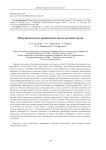
Overview of unmanned aircraft cargo delivery systems
Статья научная
The article is devoted to an overview of unmanned aircraft systems (UAS according to GOST R 59517–2021, or in a number of publications – unmanned aerial vehicles or drones) capable of delivering various cargoes. The options for their application in various fields, including agriculture and forestry, fishing, wildlife protection, air quality monitoring, mining, defense and civilian use, search and rescue operations, are given and briefly analyzed. The purpose of the study was to demonstrate the identified capabilities of unmanned aircraft systems in terms of cargo delivery for various purposes, as well as the availability of infrastructures when receiving cargo for further transportation and its delivery at the place of delivery. The history of the development of unmanned vehicle technologies is given. The relevant standards of the Rus-sian Federation, classification and categorization of UAS in the Russian Federation and abroad are pre-sented. The advantages and disadvantages of UAS are described, as well as the problems of delivering mail using drones. Conclusions are drawn about the desire of developers and trends to create intelligent, fully automatic robotic aviation systems, however, it is noted that fully automatic systems do not yet exist in the world, therefore, this area of development is relevant. It is concluded that it is necessary to carry out scientific and technical developments in terms of creating automatic delivery of mail and other items, especially relevant for megacities in which the largest part of the population of developed countries is concentrated. At the same time, it is obvious that the delivery system should consist of at least three stag-es – warehouse sorting, direct flight and navigation, and cargo shipment to the appropriate post office. Each stage is an infrastructural concept with a complex system and logistics that requires artificial intelli-gence, robotic devices, and other elements and attributes of complex systems that are subject to compre-hensive study in technical, legislative, legal, and logistical terms.
Бесплатно
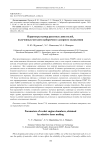
Parameters of rocket engine chambers, obtained by selective laser melting
Статья научная
When designing and testing a low-thrust rocket engine (LTRE), one of the most important tasks is to ensure the quality of materials, which, in turn, affects the reliability of the product. Currently, additive technologies for manufacturing parts from metals are actively developing. This direction is relevant for rocket and space technology products to reduce weight and increase the reliability of products. The article presents the results of studies of the chemical composition and mechanical characteristics of the material of the low-thrust rocket engine demonstrator chamber, manufactured by selective laser melting from metal powder. The properties of products made from Inconel 718 metal powder were studied. Samples were made and the chemical, mechanical and structural characteristics of the material were studied. Based on the test results, two LTRE samples were printed. LTRE chambers were tested for vibration loads, strength and tightness. Increased porosity and roughness of the test material of the engine chamber were noted. When analyzing a number of parameters of the selective laser melting technology, an experimental selection of printing parameters was carried out and the most significant factors affecting the print quality (surface roughness and porosity) were identified. Based on the results of the work carried out, four groups of controlled printing parameters were identified that affect the properties of the resulting material. The work also provides recommendations on printing modes and characteristics to obtain the highest quality parts.
Бесплатно
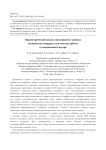
Parametric analysis of the anisogrid body of the spacecraft for cleaning the orbit of space debris
Статья научная
The article presents an approach to solving the problem of designing a spacecraft for cleaning the orbit of space debris (space garbage collector-KSM), the body of which is made in the form of a cylindrical mesh anisogrid shell. The design task is to select the optimal parameters of the anisogrid body of the KSM (the shape and cross-sectional area of the ribs, the number of annular and spiral ribs, material characteristics, etc.) that provide the necessary strength and stability of the structure with minimal weight. During the design process, a parametric analysis of the anisogrid housing of the space garbage collector was carried out. By varying the number and angle of inclination of unidirectional spiral ribs, we find the optimal design scheme that satisfies the specified safety and stability coefficients. Parametric analysis of the KSM body includes modeling of the main weight and strength parameters: determination of the stress-strain state of the structure, values of the body’s natural frequencies, determination of the bending margin from the longitudinal force, determination of the body mass. The analysis of the load-bearing capacity of the anisogrid housing of the space garbage collector was carried out by the finite element method using the MSC Nastran software package. A finite element mesh model was created from a two-node spatial finite element bundle. The disk attached to the end of the shell was modeled using a rigid finite element. The size of the final beam element for all shell models was the same and equal to 10 mm. During the parametric analysis, three variants of the mesh composite structure with a different number and angle of inclination of unidirectional spiral ribs were considered. Based on the results of parametric analysis of the spacecraft body, its geometric dimensions are determined and the mass of the spacecraft structure as a whole is minimized.
Бесплатно

Parametric analysis of the strength of a solid propellant rocket engine nozzle
Статья научная
The paper presents an approach to solving the problem of designing a solid propellant rocket engine (SPRE) nozzle using such a design feature as a carbon fiber insert plate. The design task is to select the optimal parameters of the plate shape and thickness, providing the required load-bearing capacity with minimal mass. During the design process, a parametric analysis of a SPRE nozzle with a carbon fiber insert plate was carried out. By varying the thickness of the plate, an optimal design scheme that corresponds to the specified safety and stability factors was selected. Parametric analysis of an insert plate made of a composite material includes modeling of its main weight and strength parameters: analysis of the stress-strain state of the structure, values of natural frequencies, determination of the buckling margin, and determination of a SPRE nozzle mass. The analysis of the load-bearing capacity of a SPRE nozzle with an insert plate made of a composite material was carried out by the finite element method using the SolidWorks Simulation software package. When conducting a parametric analysis, two variants of a SPRE nozzle with and without an insert plate were considered. According to the results of a parametric analysis of a SPRE nozzle, its geometric dimensions were determined and the structure mass was minimized.
Бесплатно

